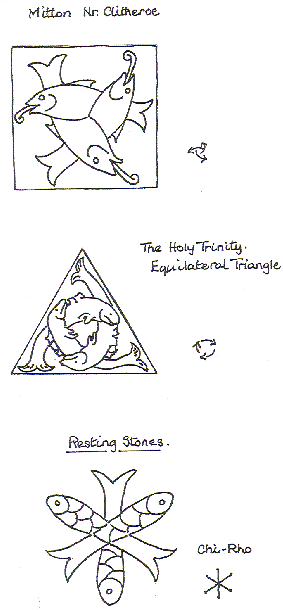| JOURNAL 2006 |
| North Craven Heritage Trust |
In last year’s journal note on the Resting Stone which lies on Giggleswick Common at a point where five townships meet the suggestion was made that Whalley Abbey had some connection with the stone carved with three fish. The following comments present a case for thinking that this is not so.
The belief of medieval craftsmen was Ars sina scientia nihil est (art without philosophical knowledge is nothing). Symbolism was important to them and I believe that the numbers of fish in the following examples can be interpreted as follows. Fish as a Christian symbol are associated with “ Be ye fishers of men ”; the number of fish portrayed on the security gate at Kirkby Malham Church has eight for eternity, while the pulpit cloth inside has four, one for each of the apostles; the unadorned clear diamond patterned windows might represent fishing nets.
The fish became a symbol used by early Christians on account of the fish mentioned at the feeding of the five thousand (Mark 6:38). Where three fish are portrayed they represent the Trinity as on the Whalley coat of arms, the Mitton stone carved fish (near Clitheroe), the wood roof boss from Bristol Cathedral, the Trinity from a Spanish manuscript, and those in the equilateral triangle from a book on Christian symbols. The triangle and double Celtic Triquetras or triangular knots also symbolise the Trinity. The direction the fish revolve appears to be insignificant.
The fish on the Resting Stone are carved in a pattern which might represent Chi-Rho (the two Greek letters denoting the name of Christ) combined with the three fish of the Trinity, so making the Resting Stone a sacred place both for the deceased and mourners on their journey to Giggleswick Church. The Parish Registers for Giggleswick note four persons (of Brownhills, Slaidburn, Gisburn Forest and Grindleton) brought to Giggleswick for burial in the early 17th C, showing that such journeys were made from some distance away. The term Resting Stone for the placement of a coffin is not unique. Near Kinross in Scotland there is another such stone (this time by the road side) which once had a plaque. Since the carrying of coffins to Church was not an uncommon event, coupled with the fact there is a group of stones, then the name Resting Stone(s) is not misplaced.
From the 12th C to the 15th C the property of Craven was divided between the four religious houses of Bolton Priory, Fountains Abbey, Barnoldswick and Sawley Abbey. The whole of the Forest of Bowland belonged to Hamerton of Slaidburn and Wigglesworth, who was, with Tempest and Waddington, the main supporter of Sawley Abbey as testified by their involvement in the Pilgrimage of Grace. The stone’s suggested connection with Whalley Abbey is therefore improbable, there being no territorial or other reason for it.


